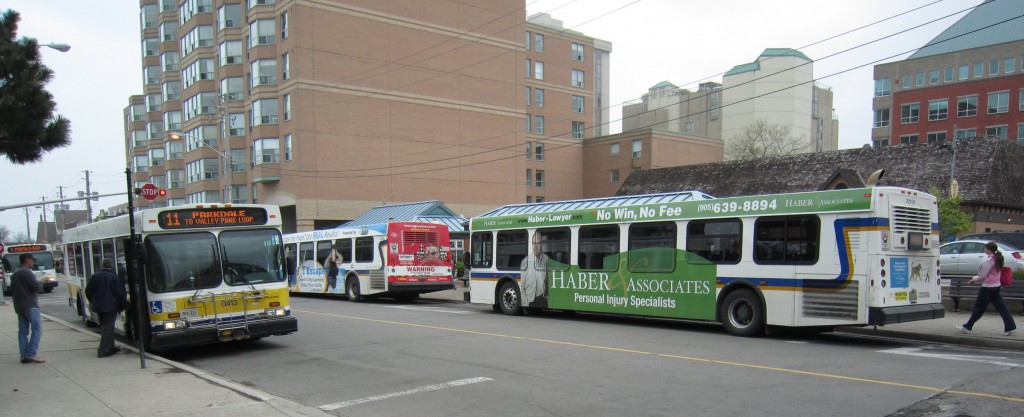 Jane Irwin has the capacity to make a point incisively and with humour. Her submission to the Master Transit Plan team are set out below in a slightly edited format.
Jane Irwin has the capacity to make a point incisively and with humour. Her submission to the Master Transit Plan team are set out below in a slightly edited format.
By Jane Irwin
BURLINGTON, ON March 22, 2012 I have used Burlington Transit for the almost 30 years I have lived in Burlington. On average, I travel by transit once or twice a week, which works out to 5 to 10 boardings per week. My most frequently traveled routes are (in numerical order, not order of frequency) 1, 2, 3, 4, 5, 6, 8 and 10.
I could not attend the public meetings because of time conflicts, but I have read the very extensive background materials online and have also read the comprehensive comments by Walter Mulkewich. The former Burlington Mayor is extremely well-informed on the topic of how transit planning is related to the future well-being of this city. His generosity in presenting his thoughts about Burlington Transit has provoked my writing to express my own more concentrated passenger viewpoint.
Travel choices are extremely important factors in three 21st-century urban goals:
to improve the city’s economic health,
to improve the health of its citizens,
and to improve the city’s environmental conditions.
Measured by these criteria, the preferred travel choices, from best to worst, are walking and cycling, transit, taxi and private car. In terms of cost, the choices are the same.
In terms of the travel time of a journey, the order is reversed: private car is fastest, then taxi, transit, cycling and walking.

Transit in Burlington is undergoing a major review that will produce a Master Transit Plan with significant public input.
The greatest opportunity for transit to compete for increased ridership is to reduce travel time to get from A to B. Everyone in today’s society appreciates more time.
The prime methods of reducing transit travel time include:
1) Greater frequency of buses, including shorter intervals for transfers.
2) Removing unnecessary bus stops ( co-coordinating bus stops with stop signs and lights).
3) More direct routes (not meandering hither and thither).
My own travel choices in recent years include walking, transit, taxi and private car. I stopped cycling 10 years ago because, in my experience, too many private car drivers in Burlington are careless of cyclist safety.
Drawing on my own experience, therefore:
1) Having to wait 60 minutes for a bus is a deal-breaker. A 30-minute wait for a bus makes other travel choices more appealing. BT should aim for a maximum of 20 minute intervals.
2) Here Irwin gets into a level of detail that will interest only those who travel the route but her point is still relevant.
Just as one example, the number 5 route west from downtown at John Street, along Ontario Street to Maple Avenue:
stop for left turn at Pine Street;
stop for left turn at Elizabeth Street:
stop for left turn at James Street:
bus stop and stop light for right turn at Brant Street;
stop for left turn at Ontario Street;
bus stop mid block;
stop sign for Locust Street;
bus stop mid block;
bus stop at Burlington Avenue;
stop sign at Hager Avenue;
two more bus stops mid block;
bus stop and stop light for left turn at Maple Avenue.
In my view, the stop sign should be moved from Hager Avenue (a 3-way stop) to Burlington Avenue (a dislocated corner, difficult for pedestrians), which should be a 4-way stop; and at least 2 bus stops should be removed. I will defer to traffic experts of course, but it seems to me an effort should be made to co-ordinate the facilitating of bus transit. It is also my view that the bus should travel on Elgin Street, thereby eliminating Ontario Street and the number 10 on Lakeshore. The Elgin Street bus stops would coincide with existing 4-way stop signs.
3) I visit Oakville on occasion, and I prefer their grid system.
For example, why not consider one Appleby line connecting with cross-town buses instead of current 5 itty-bitty lines. Walkers Line has no bus connecting Lakeshore and Fairview. Routes Brant Street 2 and Guelph Line 3 do not meet Dundas Street. BT on Dundas Street has three routes 6, 15, and 11, mostly between Walkers and Appleby Lines. Between Brant Street and Guelph Line, Route 2 meanders just south of Dundas, as do Routes 6 and 62 between Guelph and Walkers Lines.
It is really poor practice for neighbouring communities not to have joint transit on city border areas. Why not a Dundas Street bus from Brant Street to Oakville? The Oakville Dundas Street bus does not meet a Burlington bus.
Why not a bus from La Salle Park Road to Waterdown, taking a turn into Aldershot GO and VIA station?
Transfers on grid systems should be manageable with current technology, and therefore minimize delays.
Finally, in my experience, BT drivers are exceptionally courteous and helpful. The drivers are a great asset to Burlington Transit, and it should be recognized that their attitude is a factor in encouraging increased transit ridership. Congrats to BT for that!
The city’s Transit Advisory Committee doesn’t weigh in transit quite the way Jane Irwin does.
Ed note: This is not a lady to trifle with.




















I think we just may be doing something right.
Ward 2 Councillor Marianne Meed Ward said the following of a piece we posted:
This is great feedback, thoughtful and very helpful, Jane. You may have already done this, but I have shared it with transit staff and members of the Transit Master Plan Review committee, for their consideration.
Marianne
Our Burlington might get on Meed Ward’s Christmas card list.
________________________________________